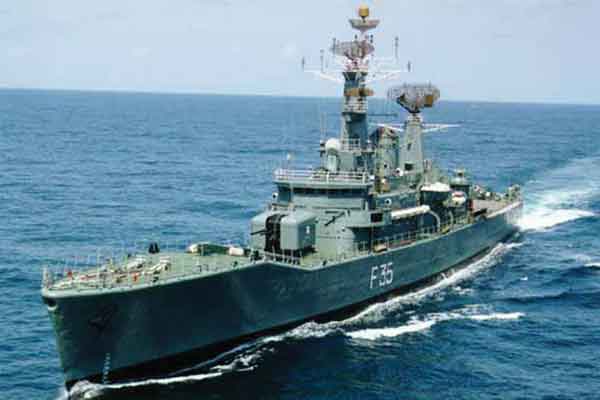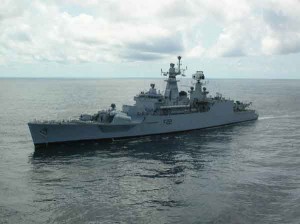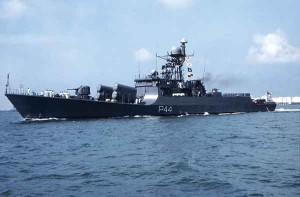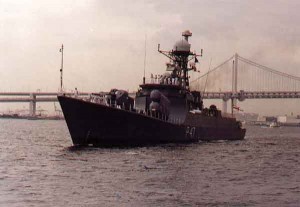Captain NS Mohan Ram recalls, “The evolution of the new design involved assessment and management of risk, innovation and extrapolation of available knowledge. The decision to go ahead was a bold act of faith on the part of the Navy. It reflected the confidence the Navy had in its young designers and the growing capability of MDL. From every point of view, the Leander Frigate Project was a monumental achievement. The courage of the decision makers, enthusiasm, perseverance and dedication of MDL, the Ministry of Defence Production and the Navy, assistance by the British Admiralty, British shipbuilding fraternity Vickers and Yarrow, the Dutch Design Bureau NEVESBU, all of these were essential ingredients of success. The astounding success of indigenisation was a direct result of the high powered Indigenisation Committee’s free, frank and helpful interaction with Indian industry through DWP and DPI (N). The enormous self confidence gained in this project by the Navy’s weapon planners, naval architects and the shipbuilder, laid the foundation for the more audaciously designed warships that later emerged from Indian shipyards.
A major objective of the 1969-1974 Defence Plan was self reliance in the field of warship design and production. The aim was to meet the Navy’s requirements through indigenous effort and conserve foreign exchange. Accordingly, the indigenous construction of frigates, patrol craft, submarines, minor war vessels and auxiliaries had been accepted in this plan. In 1969, NHQ proposed to Government that a full fledged Directorate of Naval Design (DND) be sanctioned. At that stage, the Navy did not have either adequate design experience or capability. There was also acute shortage of technical officers. NHQ had envisaged hiring designers from abroad with assurance of back-up from their parent organisations. However, negotiations with the UK for the deputation of such designers did not succeed.
The astounding success of indigenisation was a direct result of the high powered Indigenisation Committee’s free, frank and helpful interaction with Indian industry.
Meanwhile, soon after the start of the Leander construction programme, a choice had to be made whether the second and subsequent Leanders were to be identical to the first, the advantage being standardisation though at the risk of obsolescence or whether design changes should be effected from the second Leander onwards to enhance combat capability. It was decided that indigenous frigates should, as far as possible, have the latest equipment.
Rear Admiral NP Gupta, former DG Naval Design says that, “In 1970, the Directorate of Naval Design, a multi-disciplinary organisation of professional naval architects, was created. Headed by the Director General, Naval Design, it was given responsibility for undertaking design of all types of vessels, a development that augured well for the Indian Navy. The Surface Ship Design Group has successfully completed 16 design projects, of which more than 70 ships have been built indigenously.”
The warship design organisation of the Indian Navy, Directorate of Naval Design (DND) came into being in 1970. It began with the design for a new class of Seaward Defence Boats (SDBs MK2), Survey Vessels, and a Landing Ship Tank (LST). In 1973, a team of designers from the USSR were invited to visit India to suggest an organisation to design frigates and submarines. They quantified a requirement of over 170 qualified designers each for tackling the design of a new frigate and a new submarine. These requirements of manpower were just not able to be implemented within available resources. The Naval Staff, therefore, accepted the revision of the staff requirements and approved a modified Leander hull with a different weapon package instead of insisting on an altogether new frigate design. This decision was to result in the Godavari-class frigates of Project 16, which retained all the indigenous propulsion machinery and other equipment already developed for the six earlier Leanders.
In early 1975, the Design Organisation commenced conceptual design work on Project 16. By end 1975, the Naval Staff and the Government accepted the design. Detailed drawing and design work started in 1976.
Project 16 Godavari Class Frigates
The lessons learnt in the 1971 Indo-Pakistan War, the detailed discussions with Russia for the next series of Russian acquisitions and the progress made in the development of indigenous systems made it possible for the Naval Staff to consider major improvements in the combat capability of frigates. The Directorate of Combat Policy and Tactics suggested that the entire missile and gun package of the Soviet Nanuchka-class missile corvette be installed in the frigates which would follow the Vindhyagiri, together with two Seaking anti-submarine helicopters, the latest Indian APSOH Sonar, a mix of Soviet and Indian radars and Italian CAIO and EW systems. The Directorate of Marine Engineering suggested that steam propulsion be replaced by gas turbine propulsion.
Godavari was launched in May 1980 and commissioned in 1983. This project took almost nine years out of which the actual construction took five and half years. Ganga was launched in 1982 and commissioned in 1985. Gomati was launched in 1984 and commissioned in 1988. The success of implanting Russian weapons systems in the Godavari-class frigates synergised with the momentum that had built up in the indigenous warship building programme. Confidence had grown in the capability of the Navy’s Design Organisation and the warship building yards (MDL, Garden Reach and Goa Shipyard) had begun to press the Ministry of Defence Production for long-term orders to keep their workforce gainfully employed. Russia continued to offer its latest weapons for installation in Indian-built hulls. There was willingness from the Russian side to assist indigenous warship design and production. All these factors culminated in the sanction for indigenous production of guided missile destroyers (Project 15) and frigates (Project 16 A), missile corvettes (Project 25 A), gas turbine propelled missile boats (Project 1241 RE), landing ships, survey ships, tankers and diverse smaller ships.
Project 25 Khukri Class Corvettes
The Petya-class submarine chasers had been acquired from the Soviet Union in the mid-1960s. They would, therefore, need replacement in the mid-1980s. NHQ decided that their replacement would be indigenously designed and constructed as “Corvettes” for the defence of the island territories and off-shore oil rigs. In 1975, design work commenced on ships of the Corvette Project, which eventually culminated in the commissioning of the Khukri-class corvettes of Project 25. Orders for the first two corvettes were placed on MDL in 1986. Khukri, launched in December 1986, was delivered in 1989. Kuthar was launched in January 1988 and delivered in 1990. As the lead yard, MDL provided drawings and shipbuilding material inputs to Garden Reach for building the next two corvettes. Kirpan was delivered in 1990 and Khanjar in 1991. Except for the Russian weapon systems, all four corvettes were fitted with indigenous equipment to the maximum extent possible. Later in the 1990s, orders were placed on Garden Reach for four more corvettes of Project 25 A.
The warship design organisation of the Indian Navy, Directorate of Naval Design (DND) came into being in 1970.
Conclusion
As in the case of the Leander Frigate Project, the Navy’s achievements in Indigenous Warship Design were astounding. The transfer of talented young officers between the Frigate Project and the Design Organisation generated enormous synergy. Soviet warship designers and weapons system supply organisations were generous and unstinting in their help. The exchange of detailed information in the 1970s regarding the new Soviet acquisitions enabled weapons planners in the Naval Staff to suggest cost-effective staff requirements which would achieve the much needed standardisation of systems and economies in weapons inventories. The confidence built up in the MDL during the Frigate Project helped to build the ships which earned much praise from the Navies of the world.
According to Rear Admiral NP Gupta, defence sector shipyards under the control of MoD (Production) have made a significant contribution in the field of indigenous warship construction. Together, the shipyards have built more than 90 warships for the Indian Navy, many of which are of indigenous design. The shipyard is currently building complex and sophisticated programmes like stealth frigate, follow on destroyers and Scorpene submarines. Garden Reach Shipbuilders and Engineers (GRSE) have built three Brahmaputra-class frigates, six Sandhayak-class survey vessels, Magar-class Landing Ship Tanks, Fleet Tanker and Fast Attack Crafts.
The Godavari class frigates were originally built by MDL though the next series of three ships are being built in Kolkata at the GRSE. With the successful commissioning of INS Godavri, an indigenously designed and built, modern, general purpose frigate, India joined the select band of nations who can design and build their own front-line warships. This landmark was the result of combined and sustained efforts of the Navy’s Design Organisation, MDL, Naval Dockyard, DRDO, special indigenisation agencies such as the Directorate of Warships Projects, the Directorate of Production and Inspection (Navy) and a large number of contributing industries both in the public and private sectors.
The first in the Indian Navy’s stealth frigate series, INS Shivalik has already been commissioned in 2010 and the second INS Satpura was commissioned on August 20, 2011 and the third and the last in the series INS Sahyadri will be commissioned in 2012. INS Sahyadri was built and integrated by MDL. The Shivalik class frigates have low radar signature and a highly advanced Electronic Warfare Systems made by Bharat Electronics Limited. Three Kolkata-class destroyers, four advanced Anti-Submarine Corvettes, four Offshore Patrol Vessels are in various stages of construction. The construction of the first Indigenous Aircraft Carrier is in progress and it will be a jewel in the crown of the Indian Navy.
At present, the GRSE is engaged in building four ASW Corvettes. Goa Shipyard Limited has specialised in the construction of smaller vessels namely Missile Corvettes, FAC and OPVs. Rear Admiral Baxi, also later Chairman and Managing Director of Bharat Electronics Limited recalls, “First and foremost, amongst the three services, the Indian Navy has shown the greatest determination to be self sufficient and self reliant. And this was by a genre of people over generations, not merely by one individual.” Presently, the Indian Navy is the first among the services in indigenisation. Former Naval chief, Admiral Arun Prakash admits that the Indian Navy takes great pride from the fact that up to 80 per cent of its ships are sourced indigenously.
Bibliography
- Singh, Rear Admiral Satyindra, ‘Blueprint to Blue Water: The Indian Navy 1951-65’, Lancer Publishers, New Delhi.
- Hiranandani, Vice Admiral GM, ‘Transition to Triumph: The Indian Navy 1966-75’, Lancer Publishers, New Delhi.
- Hiranandani, Vice Admiral GM, ‘Transition to Eminence: The Indian Navy 1976-90’, Lancer Publishers, New Delhi.
- Hiranandani, Vice Admiral GM, ‘Transition to Guardianship: The Indian Navy 1991- 2000’, Lancer Publishers, New Delhi.
- Gupta, Rear Admiral NP, ‘Warship Building in India: Strategies & Options’, article published in SP’s Naval Forces, Defexpo Special 08, Vol.3.
- India Strategic, Sep 16 – Oct 15, 2011, New Delhi.
- SP’S Military Year Book 2008 – 2009, New Delhi.
- Force, Vol 9, No.1, Sep 2011, New Delhi.








